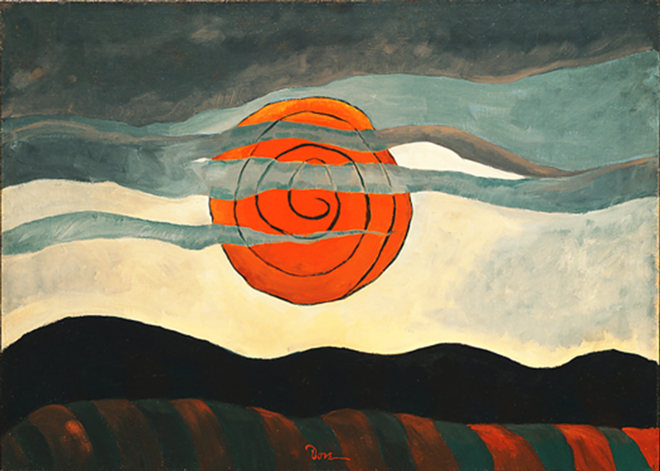
Between 1917 and ’18, Duncan Phillips, heir to a Pittsburgh steel fortune, abruptly lost his father and his elder brother, with whom he had begun collecting art just two years earlier. After grieving, Phillips turned to creating a tribute in the form of a museum, and in 1921, with his mother's support, he opened the Phillips Collection in Washington, D.C. The one-room museum featured 237 paintings and opened the same year that its founder, then 35, married artist Marjorie Acker Phillips.
Phillips’ driving passion for collecting art as an act of love and remembrance grew the museum — which he oversaw as director until his death in 1966 — to 3,000 wide-ranging modern and contemporary works.
Catching a sense of that passion is what defines a visit to To See As Artists See: American Art from the Phillips Collection, on view at the Tampa Museum of Art through April. Preceded by an onslaught of buzz and a members’ reception so crowded that TMA had to restrict traffic into its galleries, the exhibition of 107 paintings brings to Tampa a calibre of art rarely seen locally — works by Winslow Homer, Thomas Eakins, Georgia O’Keeffe, Edward Hopper, Jackson Pollock, Mark Rothko and many others. Making its third stop at an American museum before returning to D.C., the exhibition is the most impressive display hosted by TMA since reopening in 2010.
The wow factor of famous names, though, isn’t really the point of To See As Artists See. I’d even go so far as to say that some of the paintings a visitor may expect to be masterworks — e.g., pieces by Pollock or Rothko — are minor; a mostly pitch-black canvas by Clyfford Still won’t impress someone who has seen other examples of the Abstract Expressionist’s starkly beautiful works.
But what’s stellar — heartwarming, life-affirming, and intellectually fulfilling — is the exhibition's adept presentation of modern American painting as a lively, century-plus-long conversation between diverse voices and viewpoints. It takes one hell of a collection, the likes of which very few exist in the world, to be able to tell that kind of story. So while a small yellow-orange version of Rothko’s floating color fields seems kind of meh across the gallery from a bold pink-and-black symbol-covered canvas by Adolf Gottlieb (who co-founded a group of abstract painters called “the Ten” with Rothko in 1935 but wound up less famous) or even a jazzy blue drip painting by Sam Francis, the crux is that you’re standing in a room of 20 paintings that arguably represent the most progressive mind sets on art post-World War II.
The main narrative thread of the exhibition traces a progression toward post-war abstraction through earlier works and ever-changing ideas about how to see and depict the world authentically. Romantic landscapes like Albert Pinkham Ryder’s “Moonlit Cove” (1880s) and “Moonlight, Tarpon Springs” (1892) by George Inness, the renowned landscape painter who wintered in Pinellas County, used old master oil painting techniques but emphasized emotion and poetry over banal realism. In Ryder’s distillation of moon-infused clouds and a rocky shelter to organic light and dark shapes, it’s easy to preview the more radically abstracted landscapes and natural forms of Arthur Dove and Georgia O’Keeffe — both of whom were promoted by O’Keeffe’s husband, Alfred Stieglitz, at his New York gallery 291 — 30 to 40 years later.
Soon Childe Hassam, a New Englander who lived in France during the 1880s, was transposing the daub-y, pastel French Impressionist style — intended to capture truth as an impression of fleeting light — on icons of American urban life like New York’s Washington Square (1890); then Marsden Hartley, another well-traveled Yank, was making paintings such as “Mountain Lake — Autumn” (c. 1910), an electrically colorful landscape of thickly-applied blue, red and yellow paint that could pass for a work by André Derain, a French Fauvist and comrade of Matisse. By 1932, John Marin’s “Bryant Square” turned skyscrapers into cubist rectangular planes. From there, the history of American modernism could be told as an exhilarating downhill ride all the way to Jackson Pollock’s dribbles.
To the credit of To See As Artists See, the exhibition offers a more nuanced story, melding the obligatory view of modernism as a progression toward abstraction (largely dominated by New York-based male painters who had studied in Europe) with the plurality of voices and views increasingly recognized in art history and museum displays. The modernism on tap at TMA has room for self-taught artists like Grandma Moses and Horace Pippin, whose “Domino Players” (1943) pictures African-American women at leisure; both artists painted in straightforward, realistic styles that earned them legions of fans. And for works by Jacob Lawrence, who purposefully adapted the innovations of abstraction to visualize African-American history, living with one foot in Harlem and one foot in an elitist New York art world in the 1940s, and Yasuo Kuniyoshi, who blended Japanese aesthetics with American folk traditions and came away with the first solo show granted to a living artist by the Whitney Museum of American Art in 1948.
It’s hard to imagine a more fitting portrait of American modernism than To See as Artists See — and difficult to imagine the possibility of one without the passionate interest and impassioned collecting of Duncan Phillips.

